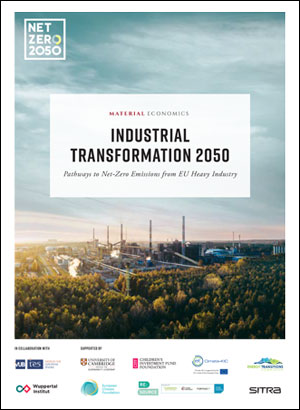April 2019 – The report, supported and co-funded by the University of Cambridge Institute for Sustainability Leadership (CISL), sets out multiple possible pathways the EU could pursue to achieve the full decarbonisation of its heavy industries by 2050.
Heavy industry is one of the sectors of the EU economy with stagnating CO2 emissions abatement and significant fossil fuel use. Previously perceived as the 'hard to abate' industrial sectors, steel, chemicals, and cement account for about 14 per cent of Europe’s annual emissions. While other sectors are accelerating their emissions reductions, the share of emissions from heavy industry will increase dramatically under business as usual. As such, industry has a key role to play in the decarbonisation of the European economy to fulfil the EU’s commitments under the Paris agreement.
The research was carried out by the consultancy Material Economics and commissioned by the European Climate Foundation, with the support of CISL, Climate Kic, Energy Transitions Commission, and Sitra.
The report suggests that the following methods should be employed to enable climate neutrality in heavy industry:
- A more circular economy is a large part of the answer. Increased materials efficiency throughout value chains could cut 58–171 Mt CO2 per year by 2050.
- Reusing materials that have already been produced can also result in large emission reductions. By 2050, 70 per cent of steel and plastics could be produced using recycled feedstock.
- In the case of plastics, using end-of-life plastics as feedstock for new production could significantly reduce the need for fossil fuels to produce new plastics.
- Innovations in new, clean production processes; between 143–241 Mt CO2 per year could be cut by 2050 by deploying new industrial processes.
- Carbon capture and storage/use (CCS/CCU). CCS and CCU will be required to cut between 45 and 235 MtCO2 emissions per year by 2050. However, as the study highlights, these measures are not a ‘plug and play’ solution and would require access to suitable transport and storage infrastructure.
The report highlights the following incentives and benefits to the decarbonisation process:
- Ten years ago Europe was an undisputed leader in a wide variety of renewable energy and low carbon products and services. It now has the chance to boost the competitiveness of its industry by developing sustainable solutions that will be needed globally.
- Switching from the import of large quantities of fossil fuels and feedstocks to home-grown resources would significantly reduce European industry’s dependence on energy imports and will foster Europe’s energy trade balance.
The costs of the transition
- Thanks to a more circular economy and affordable electricity, consumer prices of cars, houses and packaged goods would increase by less than 1 per cent. Overall, the additional costs of achieving zero emissions are around 0.2 per cent of projected EU GDP by 2050.
- However, the business-to-business impact can be challenging and must be managed carefully. Therefore, strong policy support will be needed in the near term to ensure companies remain profitable in the transition.
Citing this report
Please refer to this report as: Material Economics (2019). Industrial Transformation 2050 - Pathways to Net-Zero Emissions from EU Heavy Industry.




